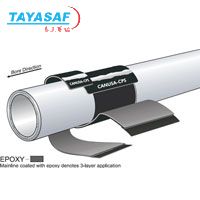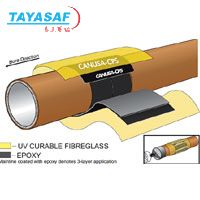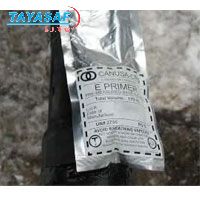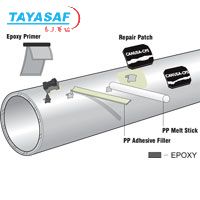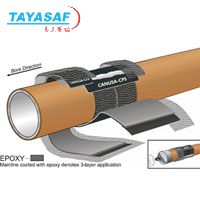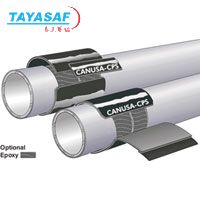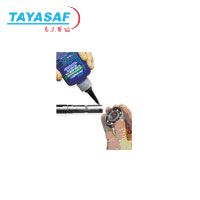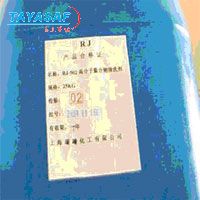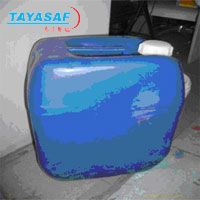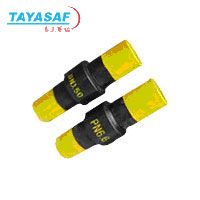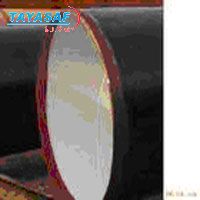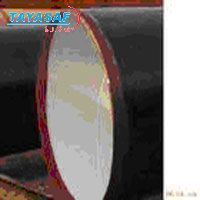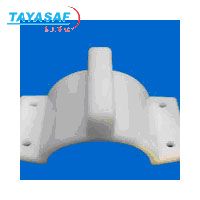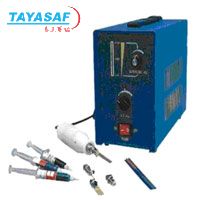GasketSeal® Sealing Gaskets are considered to be one of the most effective methods for sealing mating surfaces of all types. The gasket consists of two molded half “O” rings (with precise crown-to-void ratio) mounted in grooves on opposite sides of a retainer. While maintaining all the advantages of a full “O” ring seal, the half “O” rings eliminate the need for sealing grooves in the mating surfaces, which also eliminates positioning and alignment concerns. GasketSeal gaskets are available in a wide variety of retainer and sealing element combinations for matching gaskets to service and environmental conditions.
Near zero "M" and "Y" factors make it possible to effect a positive seal without the tremendous bolt loads required with flat gaskets. Low compressive loads on the gasket allows the use of lighter weight and lower pressure rated flanges where permitted.
Unique features of the GasketSeal® Sealing Gasket:
Eliminates flange leaks.
Guards against blowouts.
Protects against fire and hostile environments.
Usable with any type of flange.
Matches gasket materials to service conditions.
Lowest possible clamp and compressive load.
Increases gasket life.
Insulating version is both a positive seal and a superior insulator.
Available in all standard ANSI and API flange sizes from 1/2” and above.
Available in custom odd sizes and shapes.
Available in pressure Ratings for all ANSI and API rated flanges.
For pressures from hard vacuum to 50,000 psi and higher.
How GasketSeal® Works
Before Tightening
The flange faces come into contact with the crown of the sealing elements. As the flange is tightened the crowns are compressed into the molded-in voids in the sealing elements, resulting in a seal that will maintain positive, dynamic contact against the flange faces under all conditions.,
After Tightening
The flange faces have come into firm contact with the retainer, thus encapsulating the sealing elements within grooves and guarding them from exposure to external environments or internal media. At the same time, the elastic memory characteristics of the confined sealing elements results in zero “m” and “y” factors, making it possible to effect and maintain a positive seal at the lowest possible compressive load.,
Wide Choice of Gasket Materials
|
Metal Retainer
Materials |
Insulating Retainer
Materials |
Sealing
Elements |
|
Aluminum
Brass
Carpenter 20
Carbon Steel
Cast Iron
Clad Steel Materials
Copper
Ductile Iron
Hastelloy B, C, X
Inconel X
Monel
Nickel 200
Soft Iron
Stainless Steel
Tantalum
Tin
Titanium
Vanadium |
Ceramic
Epoxy Glass
Glass
Lucite
Melamine
Phenolic
Polyester Glass
Polyethylene
Silicone Glass
Vinyl |
Buna-N (Nitrile)
Buna-S
Butyl
EPDM
Hypolon
Kel-F
Natural Rubbers
Neoprene
Nylon
Polyurethane
Silicone Rubber
Viton®
® DuPont |
Suggested Sealing Gasket Material Compatibility
|
Medium |
Retainer |
Seal |
Temperature
Range °F |
Temperature Range °C |
|
Acetone |
Phenolic |
Nitrile |
+32 to +80 |
0 to +27 |
|
Air |
G-10 |
Nitrile |
-65 to +225 |
-54 to +107 |
|
Carbon Dioxide |
G-10 |
Nitrile |
+32 to +150 |
0 to +66 |
|
Ethanol |
G-10 |
Nitrile |
+32 to +100 |
0 to +38 |
|
Fuel Oil |
G-10 |
Viton |
-20 to +280 |
-29 to +138 |
|
Gas, Natural |
Phenolic |
Nitrile |
-65 to +220 |
-54 to +104 |
|
Gas, Sour |
Phenolic |
Viton |
-20 to +220 |
-29 to +104 |
|
Gasoline |
G-10 |
Teflon |
-65 to +225 |
54 to +107 |
|
Hydrogen |
G-10 |
Nitrile |
-65 to +250 |
-54 to +121 |
|
Jet Fuel |
G-10 |
Viton |
-20 to +225 |
-29 to +107 |
|
Nitrogen |
Phenolic |
Nitrile |
-65 to +220 |
-54 to +104 |
|
Oil, Crude |
G-10 |
Viton |
-20 to +280 |
-29 to +138 |
|
Propane |
G-10 |
Nitrile or Teflon |
+32 to +80 |
0 to +27 |
|
Propylene |
G-10 |
Viton |
+32 to +80 |
0 to +27 |
|
Sewage |
G-10 |
Viton |
-20 to +280 |
-29 to +138 |
|
Toluene |
G-10 |
Viton or Teflon |
+32 to +150 |
0 to +66 |
|
Water (Hot) |
G-10 |
Nitrile |
+175 to +250 |
+79 to +121 |
|
Water (Potable) |
G-10 |
Nitrile |
+32 to +250 |
0 to +121 |
|
Water (Sea) |
G-10 |
Nitrile |
+32 to +250 |
0 to +121 |
General Notes:
The foregoing performance data are intended as guidelines only. Performance suitability for any specific applications should be determined by the user. Variation in temperature, pressure, concentration or mixtures acting synergistically may preclude suggested service use. Material selection is at the sole risk of the user. Consult with a specialist for specific applications. PSI's responsibilities will be limited to those listed in the PSI standard warranties.
Metal Retainers:
GasketSeal gaskets are available with a wide range of metal retainers to offer compatibility with flange metals, for extremely hazardous fluids, or for extremes in temperatures and pressures. Please contact Corrosion Control Products Company.
Physical Properties
GasketSear® and LineBacker® gaskets are available in a wide variety of retainer and sealing element combinations for matching gaskets to service and environmental conditions. This greater variety of materials also provides excellent temperature and chemical range compatibility.
|
ASTM |
Test
Parameter |
Plain
Phenolic |
Neo-Faced
Phenolic |
G3
Hi-Temp
Phenolic |
G-7*
Silicone
Glass |
G-10
Epoxy
Glass |
G-11
Epoxy
Glass |
|
D149 |
Dielectric Strength
Volts/mil (short time) |
500 |
500 |
500 |
350-400 |
550 |
550 |
|
D695 |
Compressive Strength (psi) |
25,000 |
25,000 |
50,000 |
40,000 |
50,000 |
50,000+ |
|
D229 |
Water Absorption (%) |
1.6 |
1.6 |
0.7 |
0.07 |
0.10 |
0.10 |
|
D257 |
Insulation Resistance (MOhms) |
40,000 |
40,000 |
46,000 |
2,500 |
200,000 |
200,000 |
|
D790 |
Flexural Strength (psi) |
22,500 |
22,500 |
60,000 |
27,000 |
60,000 |
75,000+ |
|
D785 |
Hardness Rockwell "M" |
85 |
85 |
115 |
105 |
115 |
115 |
|
D256 |
IZOD Impact Strength
(ft-lbs/inch) |
1.2 |
1.2 |
12.0 |
8.0 |
14.0 |
12.0 |
|
D638 |
Tensile Strength (psi) |
20,000 |
20,000 |
42,000 |
25,000 |
45,000 |
43,000 |
|
D732 |
Shear Strength (psi) |
10,000 |
10,000 |
18,000 |
20,000 |
22,000 |
22,000 |
|
|
Operating Temperature,
degrees F |
-65 to
+220°F |
-65 to
+175°F |
-65 to
+392°F |
Cryogenic
to +450°F |
Cryogenic
to +280°F |
Cryogenic
to +349°F |
|
|
Operating Temperature,
degrees C |
-54 to
+121°C |
-54 to
+79°C |
-54 to
+200°C |
Cryogenic
to +138°C |
Cryogenic
to +280°C |
Cryogenic
to +176°C |
G-7 material should not be used with hydrocarbons, not even trace amounts.
Seal Element Temperature Limits
|
Nitrile |
Viton |
Teflon |
Neoprene |
EPDM |
|
-65 to +250°F |
-20 to +350°F |
Cryogenic
to +450°F |
-40 to +175°F |
-65 to +300°F |
|
-54 to +121°C |
-29 to +177°C |
Cryogenic
to +232°C |
-40 to +79°C |
-54 to +149°C |

 泰亚赛福 —— 世界领先的检测仪器集成供应商
泰亚赛福 —— 世界领先的检测仪器集成供应商 


 您当前的位置:
您当前的位置: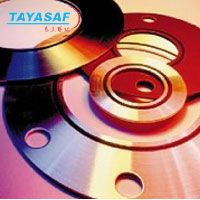

 加入对比
加入对比

